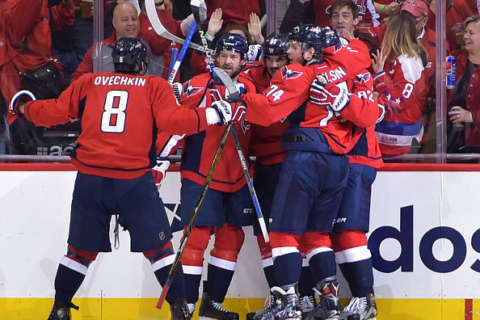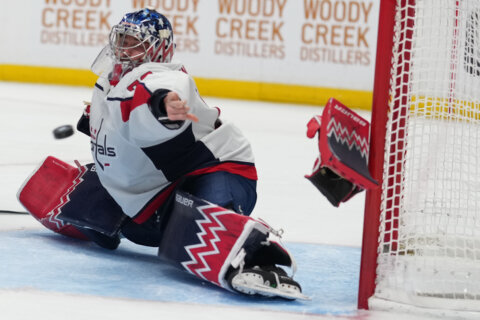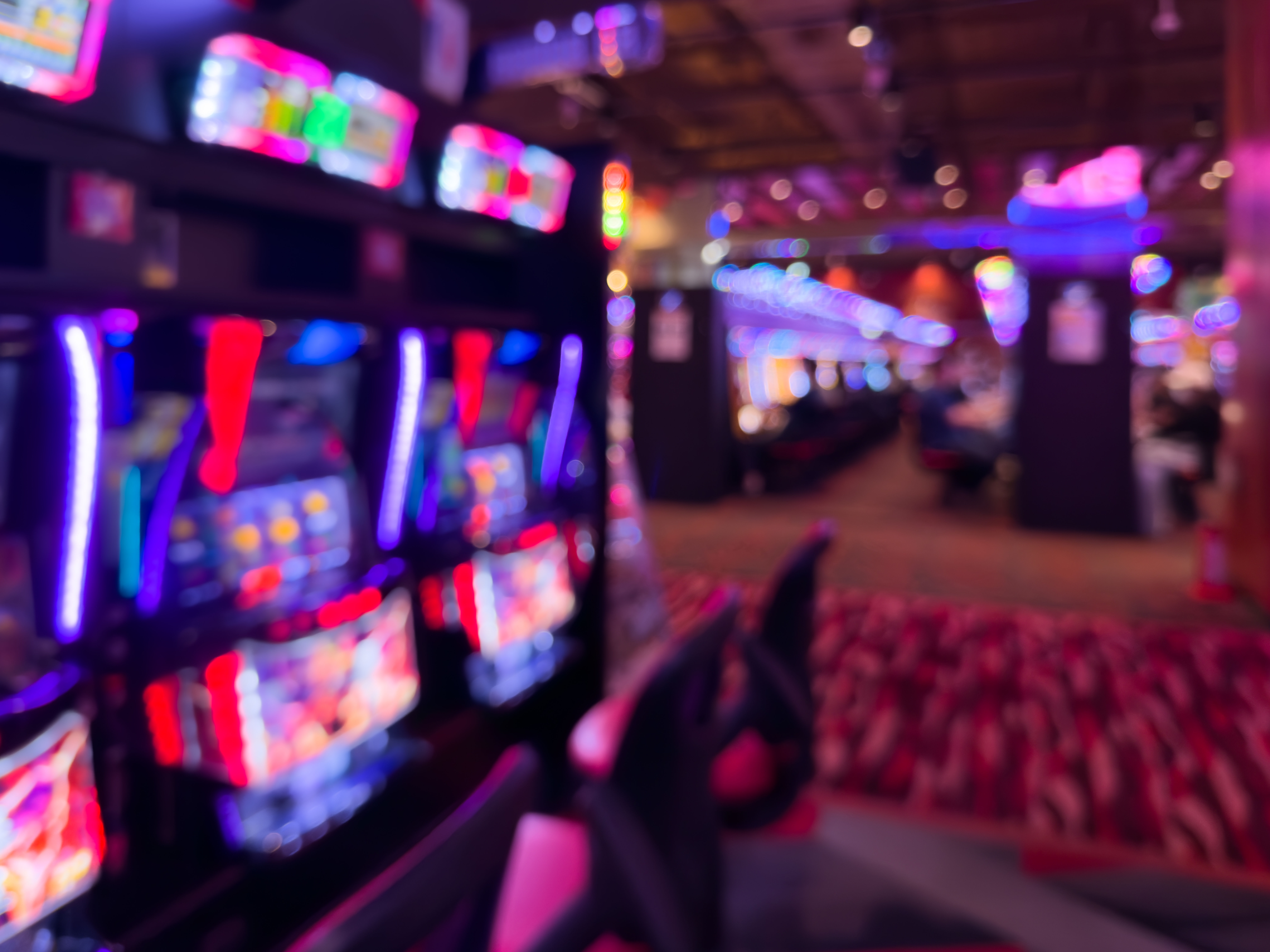25 years at Capital One Arena: How DC became a hockey town originally appeared on NBC Sports Washington
WASHINGTON — The D.C.-area snowstorm of February 2010 is remembered by many residents and meteorologists as Snowmageddon, a 17.8-inch blizzard that went down as the fourth-biggest snowfall in the city’s recorded history.
Local hockey fans, however, remember the storm by another name. On Feb. 7, only a day after the snow had finally stopped falling, more than 18,000 Capitals fans trudged through the white-blanketed streets to fill Verizon Center for a huge matchup against their bitter rival, and reigning Stanley Cup champion, Pittsburgh Penguins.
With all flights in and out of the District canceled, the Penguins were forced to travel by bus from New Jersey, where they played the Devils in Newark on a Saturday, just to make it to D.C. for a Sunday afternoon matinee.
Capitals fans overcame plenty of their own travel issues to get there as well, but it only fueled the energy of a raucous crowd that thundered on as Alex Ovechkin scored a hat trick to lead a 5-4 comeback win in overtime. His performance, and later the snowstorm itself, came to be known as Snovechkin.
Now named Capital One Arena, the Capitals’ home venue has been the site of many historic games and sold-out crowds since it opened in 1997. Monday marks the 25th anniversary of the first night the arena opened its doors to Capitals fans. As the team evolved from basement dwellers to perennial championship contenders, the fan base cultivated an arena atmosphere that has come to rival that of even some of the oldest teams in the NHL.
“There’s something about the energy here at Capital One Arena,” public address announcer Wes Johnson said. “The energy that’s in that building has been legendary and the noise level has been like several jet engines when the crowd gets crazy.”
Whether it be for a regular-season game in the middle of a snowstorm or Game 4 of the Stanley Cup Finals, Capital One Arena has managed to keep its roof intact even as scores of hockey fans fueled their team with cries of “Unleash the fury” and chants of “Let’s go Caps.” It’s an environment the Capitals have spent the last quarter-century fostering.
**
For their first eight years of existence, on-ice success eluded the Capitals. The late Abe Pollin founded the team in 1974-75 and hosted both them and the NBA’s Bullets at the newly built Capital Centre in Landover, Maryland. It wasn’t until 1983 that the Capitals made their first playoff appearance, still trailing in popularity to the other professional teams in the area.
“In the very beginning of the hockey expansion team in Washington, you had your 20,000 diehards and that was it,” said security staff member John Kelly, who has stood guarding the penalty box since being hired as a teenager in 1976.
“They really weren’t a city-wide team the way the football team was. Everybody and their brother was passionate about the football team. We had a very small fan base in the beginning and it wasn’t until they traded for Rod Langway from the [Montreal] Canadiens and he came down and they started winning…it went from just that little hardcore to everybody starting to pay attention to them.”
The Capital Centre began as a revolutionary venue, becoming the first arena to sport a hanging instant replay board over the center of the floor and introducing the concept of luxury boxes to the indoor venue space. However, over time it was clear the arena could only do so much to enhance the fan experience.
Shaped like a bowl, the seats stretched all the way from the glass to the roof with no tiered overhangs to break up the levels. Fans at the top were far away from the action and the arena overall was not very well-lit. With no public transportation access, the traffic situation before and after games often proved problematic.
Pollin had already been looking to move his teams into D.C. when he agreed to provide most of the funding for a $200 million arena — the Washington Business Journal reported that the final cost approached $300 million — in the commercial district next to Chinatown. The MCI Center officially opened with the newly renamed Wizards hosting the Seattle SuperSonics on Dec. 2, 1997. Three days later, the Capitals played their first game in their new home, beating the Florida Panthers 3-2 on an overtime goal scored by journeyman center Jeff Toms.
“We were kind of worried a little bit that maybe with the new building, it would be a little antiseptic and we might lose that rowdy crowd reaction kind of stuff,” Kelly said. “That turned out not to be the case because the seats were closer, everybody was closer to the action. It made it louder and it was fun. It was really exciting to get into the new building and see how it was set up and how the crowd experience was going to be enhanced.”
The Capitals reached the Stanley Cup Finals in their very first year at the MCI Center as stars like winger Peter Bondra and goaltender Olaf Kölzig put together dominant campaigns. Though they were swept by the Detroit Red Wings in four games, the team went on to set a new franchise attendance record the following season with 17,251 fans per game.
“We really take time and we really meet and discuss the best ways to engage the fans and how we can keep things entertaining and give them an experience in which they really want to come back [to] not only see the game, because we know that they’re here first to see the game, but…we try to really encompass a lot of different and exciting things to offer to the fans when they come here and that has grown so much over the years,” said Vice President of Technical and Broadcast Operations Quentin Addison, an arena employee since 1998.
With more fans closer to the action and a center-floor scoreboard that was the largest of any arena in the U.S. at the time, the MCI Center provided attendees with a first-rate viewing experience. The Capitals took a few years to recapture the success that they had in their first season, but the arena was ready for when the Ovechkin era began.
**
“Rock the red.”
If there is one moment that encapsulates when D.C. truly became a hockey town, it’s likely the 15:01 mark of the third period in Game 7 of the Capitals’ first-round series against the New York Rangers on April 28, 2009. Ovechkin had already established himself as one of the NHL’s bright young stars, but his team had still been working to that point to enjoy similar success.
The hiring of Bruce Boudreau as head coach early in the 2007-08 season changed everything. Donning new red jerseys that made their debut that season, the Capitals needed a miracle to reach the playoffs and they made one for themselves. They finished the regular season on an 11-1 tear and clinched a playoff spot on the final day. Ovechkin scored a franchise-record 65 goals, a feat no one in the NHL has accomplished since.
“When Ovi first came in, he was the one-man-show-type thing,” former organist Bruce Anderson said. “I think there was a big curiosity factor. He was just so exciting to watch play and things really started escalating as far as the fan base…The biggest change I noticed was when they switched to the red. When they went from the old black retro uniforms to the red and Bruce Boudreau got in there, that’s when I thought it really took off.”
Washington didn’t make it past the first round that season, but D.C. was hooked. The stands at the Phone Booth, as the arena came to be called, flooded with red jerseys the following year, kicking off a streak of 12 straight seasons in which the Capitals averaged at least 18,000 fans per game that was only broken by the coronavirus pandemic.
The “Young Guns” promo that the team ran to highlight its young core of Ovechkin, Nicklas Backstrom, Alexander Semin and Mike Green stuck as Washington put up a 100-point season for only the second time in the previous two decades. That set that stage for Game 7 against the Rangers, when Sergei Fedorov scored the game-winner to send Capitals fans into a frenzy.
“The fans are going crazy,” NBC Sports Washington’s Craig Laughlin said on the Comcast SportsNet broadcast.
It was just the beginning, as the Capitals would go on to reach the playoffs 11 of the next 12 years including their Stanley Cup title run in 2018. With the Rock the Red era in full effect, the Verizon Center’s game presentation staff took advantage.
Larger crowds brought greater opportunities to get the fans involved during games and the Capitals sought to do that through music and movie clips. After the Atlanta Thrashers found success utilizing the line “Unleash the Fury” line from actor Tom Green’s character in the movie “Road Trip,” the Capitals put together their own rendition that soon became a battle cry for fans at the arena.
“Everybody wanted to unleash the fury every game but you can’t unleash the fury every game,” Wes Johnson said. “Unleash the fury is a tool, it’s a weapon. It’s something we can use [to] weaponize our fan base against the opposition. We don’t want our guys to get so used to it…we want to pump them up.”
On the music side, Anderson manned the organ for 22 years.
“At first, I really only did some, ‘Let’s go Caps’ and things like that,” Anderson said. “That was always exciting. Later on, I got a different keyboard and a different organ and started to integrate a little more pop stuff into it. So I tried to stay current with whatever songs had a catchy hook people would recognize on the organ.”
Meanwhile, the in-arena music playlist evolved from year to year.
Rock was the most common genre to greet fans’ ears early in Ovechkin’s career, paving the way for the famous opening video that depicted several players as members of a rock band complete with Ovechkin as the lead singer, Semin and Brooks Laich on the guitar, Green playing drums and Backstrom strumming bass. Goalie Jose Theodore was a backup vocalist as well. But as the years went on, the music started to shift in other directions.
“I’ve seen more of an increase over the years in EDM, a little more hip-hop getting involved — which is awesome because it’s a lot more reflective of D.C. — and I think that we’ve kind of gone away from the loud, screamy music,” said Jordan Greenberg, the team’s arena DJ since 2004. “A lot of it’s the European influence on the team where you have a lot of EDM, a lot more dance music…so it’s been a change in the genres a little bit but it’s been more getting the crowd involved, especially the last two-three years we’ve had a lot of crowd sing-alongs.”
In the season following their Stanley Cup title, the arena began playing individual goal songs for players and it was an immediate hit. T.J. Oshie selected “Take Me Home, Country Roads” by John Denver because of how he thought the crowd would feed off it. Now, the song is synonymous with him.
**
Under the ownership of Ted Leonsis, Capital One Arena has been at the forefront of technological improvements for indoor sports arenas.
The scoreboard has been replaced twice, now featuring 360-degree continuous video screens and an LED sky ring in addition to ribbon video boards all across the arena. An on-ice projector has paved the way for the arena’s production team to incorporate the playing surface in its light shows and video montages, resulting in creative packages like mascot Slapshot stealing the Declaration of Independence in a pregame skit inspired by the movie “National Treasure.”
Two separate phases of renovations from 2017-19 totaling $55 million resulted in the construction of the video boards, upgraded concession stands, a revamped team store and new seating across the arena to replace the purple cushions from before. It’s all helped create an environment to help keep fans engaged and coming back for more.
“The thing that I remember, to be honest with you, is the relationship the staff has with the guests,” said Kenneth Copland, a guest relations manager who first started as an usher when the arena opened. “It got beyond just a guest or a fan to a friendship…Some of the fans would come and they’d have little kids with them. Now when they come, it’s like I’m looking eye to eye to the person I was looking down to. You can see the kids grow up and it makes you think about, ‘Man, I’m getting old.’”
Now that the arena has moved past its silver anniversary, what’s next? Director of Game Presentation Alexa Ikeler has some ideas.
“The biggest thing for us, and we’re still trying to figure it out, is player puck tracking,” Ikeler said. “That’s huge for the NHL right now where we can individually tag players or we can tag the entire line that’s out on the ice and show our fans who’s on the ice. And that’s so relevant right now with Ovi chasing Gretzky’s record.”
The Tampa Bay Lightning used puck tracking and their own on-ice projector at their in-arena Stanley Cup Finals watch parties last season to show fans where players were on the ice in real time. It’s something Ikeler suggested the Capitals could do during intermissions to simulate replays in a unique way.
As Capital One Arena continues to adapt, the venue will stand as a D.C. landmark that not only houses some of its sports teams but also has revitalized a once-downtrodden area of the city and helped a fan base grow into one of the biggest hockey followings in the country.
“To me, that kind of love and comradery that everybody had together there in 2018 when the Capitals won the Stanley Cup, the masses that surrounded the building, that were in the building, is what that building has been all about,” Johnson said. “It’s community. It’s family. It’s, for some, a way of life and, for others, it’s an identity.”






